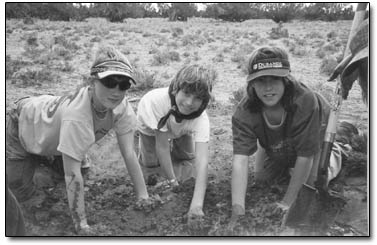(Editor’s note: Lucy Richards
is an eighth-grade student at the Red Cliff School. The entire
student body of the private middle school visited the Navajo reservation
in northern Arizona from April 28-May 2 and worked on service
projects. The trip was conducted through Deer Hill, a service
program for teen-agers founded by Durango locals Doug and Bev
Capelin.)
 |
| Red Cliff students, from left,
Niko Peha, Ethan Wanger and Nora Richards get their hands
dirty working to rebuild a sweat lodge on the Navajo Reservation./
Photo by Melanie Cook. |
The raucous clang of cow bells
announces the approach of more than 60 sheep on their way out
to pasture. The group is a mass of black and white wool and
protruding legs that seem to be too bony to withstand the constant
clatter. A ewe that has been separated from the cluster cries
for its lamb and is answered by a black newborn that has only
just been allowed to walk with the herd.
This image is one of the many memories of the annual Red Cliff
School trip. Hosted by Deer Hill, the trip was the finale to
a study unit on American Indians and was intended to introduce
the class to traditional Navajo culture. We were taken to a
ranch owned by Milton Bluehouse, where we would assist in various
service projects, and in return Mr. Bluehouse would introduce
us to the Navajo culture. The ranch consisted of a house, a
barn, a corral, a Navajo hogan and thousands of acres of open
space. Mr. Bluehouse welcomed us warmly, and after a simple
speech he gave us our first assignment – to build our
outhouse. I watched the shock on my friends’ faces as
he explained that we would have to dig a hole, but we were polite
enough not to say anything. He directed the boys to one area
and the girls to another, and instructed us to dig a hole about
3 feet deep. Over this we placed a wooden box with holes in
the bottom and a top that he had made only a few days ago with
some spare planks and nails. To the relief of all, we were also
given some cardboard for walls and rods to act as support. Our
bathroom for the five days was soon finished, complete with
a door we had fashioned and a pen for drawing on the walls.
Although this outhouse did not have the conveniences of today’s
bathrooms with flushing toilets, sinks, soap and showers, we
found the crude replica to be adequate.
The days ahead involved assorted tasks assigned by Mr. Bluehouse,
including taking apart an old wooden outhouse, transporting
sand and wood, making a fire circle and repairing a sweat lodge.
Throughout the week many of the students were able to speak
to Mr. Bluehouse, and we found him amusing and intelligent.
He began teaching a few of us simple phrases in Navajo, but
the unfamiliar sounds and words were challenging to imitate,
and we spent the rest of the trip practicing our pronunciation.
After we repaired the sweat lodge we were allowed to go inside
and were taught the traditional chants preceding the experience.
Sheep also played a huge role during the trip. Although only
two of us were allowed in direct contact with them during the
week, much of our free time involved looking at and learning
about the sheep. Some 60 or so carachols, sheep that originated
from the Middle East, lived on the ranch. Each day Mr. Bluehouse’s
wife, Irma, herded the sheep onto the open land where they were
allowed to roam as they wished under her protection. During
our visit, two lambs were born, and we amused ourselves for
hours watching their maladroit attempts at walking.
Our new farm lives changed when we went to Wide Ruins School,
a boarding and day school with an all-Navajo student body in
Ganado, where we were able to tutor kindergartners and first-graders.
Many of us enjoyed learning about the differences in teaching
methods while associating with younger children.
After the trip, everyone knew they had glimpsed a closeness
to nature that we would never be able to emulate. In our world
of computers and technology, there is no time for the closeness
and freedom of the outdoors, but we knew this experience would
change our views forever. We have acted as a bridge between
two differing cultures, one that treasures nature and one that
prizes technology. This link was necessary in the past, it is
needed now, and will forever be necessary.

